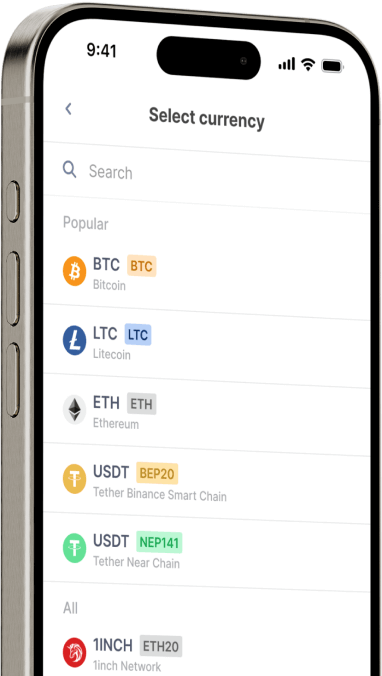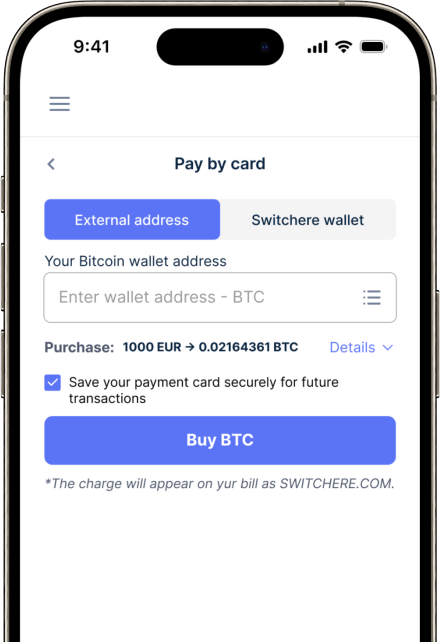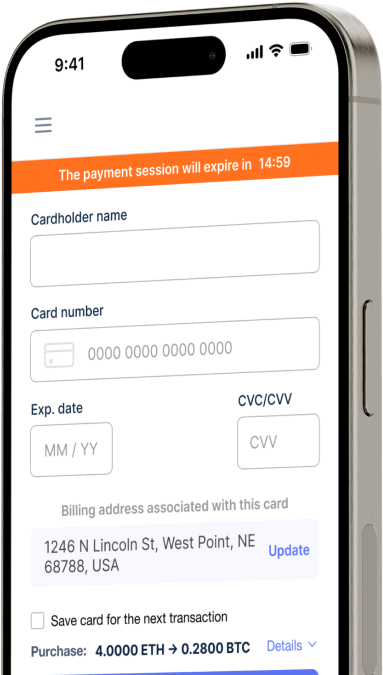전환하다
Swiss Franc (CHF)에서 Avalanche (AVAX)로 즉시
Switchere에서 Avalanche (AVAX)로 Swiss Franc (CHF)를 간편하게 구매하고 빠르고 안전한 거래의 혜택을 누리세요.
정보
Avalanche (AVAX)
아발란체(AVAX)는 확장성이 뛰어난 블록체인 기술 플랫폼으로, 탈중앙화 애플리케이션(dApp)을 호스팅하고 맞춤형 블록체인 네트워크를 쉽게 생성할 수 있도록 설계되었습니다. 주요 목적은 높은 처리량, 짧은 지연 시간, 강력한 탈중앙화를 제공하여 블록체인의 트릴레마를 해결하는 것입니다. 아발란체는 새로운 합의 메커니즘, 지분 증명(PoS) 기반에 구축된 프로토콜 제품군(스노우맨 등)을 통해 이를 달성하여 1초 미만의 트랜잭션 완결성을 가능하게 합니다. 따라서 까다로운 디파이 애플리케이션과 암호화 보안이 필요한 엔터프라이즈급 솔루션을 위한 매력적인 디지털 자산 인프라가 될 수 있습니다.
핵심적인 특징은 개발자가 자체 규칙, 가상 머신(C-Chain의 EVM 호환성 포함), 토큰노믹스를 가질 수 있는 맞춤형 애플리케이션별 블록체인을 출시할 수 있는 아발란체의 서브넷 아키텍처입니다. 이러한 서브넷은 독립적으로 운영되거나 기본 네트워크와 보안을 공유할 수 있습니다. 기본 유틸리티 토큰인 AVAX는 이 탈중앙화 네트워크 내에서 중요한 역할을 합니다. 거래 수수료를 지불하고, 검증자의 스테이킹을 통해 네트워크를 보호하며, 여러 서브넷에서 기본 계정 단위로 사용됩니다. 아발란체는 선도적인 레이어 1 스마트 컨트랙트 플랫폼으로 인정받고 있으며, 웹 3.0 인프라의 혁신을 주도하고 다양한 온체인 생태계를 육성하고 있습니다.
다른 150개 이상의 암호화폐를 Swiss Franc (CHF)에 구매하기
Swiss Franc (CHF)의 다른 코인
-
CHF에 대한 ZRX
-
CHF에 대한 1INCH
-
CHF에 대한 AAVE
-
CHF에 대한 ACH
-
CHF에 대한 ALGO
-
CHF에 대한 TLM
-
CHF에 대한 ANKR
-
CHF에 대한 APE
-
CHF에 대한 NFT
-
CHF에 대한 API3
-
CHF에 대한 APT
-
CHF에 대한 ARPA
-
CHF에 대한 AUDIO
-
CHF에 대한 AVAX
-
CHF에 대한 AVAX
-
CHF에 대한 AXS
-
CHF에 대한 BADGER
-
CHF에 대한 BAL
-
CHF에 대한 BNT
-
CHF에 대한 BAT
-
CHF에 대한 BNB
-
CHF에 대한 BSW
-
CHF에 대한 BSV
-
CHF에 대한 BLUR
-
CHF에 대한 BONE
-
CHF에 대한 CTSI
-
CHF에 대한 CELR
-
CHF에 대한 CELO
-
CHF에 대한 CEL
-
CHF에 대한 LINK
-
CHF에 대한 CHZ
-
CHF에 대한 CHR
-
CHF에 대한 C98
-
CHF에 대한 COMP
-
CHF에 대한 CFX
-
CHF에 대한 PEOPLE
-
CHF에 대한 CVX
-
CHF에 대한 ATOM
-
CHF에 대한 CTC
-
CHF에 대한 CRV
-
CHF에 대한 DAI
-
CHF에 대한 DASH
-
CHF에 대한 MANA
-
CHF에 대한 DENT
-
CHF에 대한 DGB
-
CHF에 대한 DYDX
-
CHF에 대한 XEC
-
CHF에 대한 EOS
-
CHF에 대한 ETC
-
CHF에 대한 ENS
-
CHF에 대한 ETHW
-
CHF에 대한 FET
-
CHF에 대한 FIL
-
CHF에 대한 FLOKI
-
CHF에 대한 GALA
-
CHF에 대한 GNO
-
CHF에 대한 ONE
-
CHF에 대한 HBAR
-
CHF에 대한 HOT
-
CHF에 대한 HOOK
-
CHF에 대한 ICX
-
CHF에 대한 ILV
-
CHF에 대한 IMX
-
CHF에 대한 INJ
-
CHF에 대한 ICP
-
CHF에 대한 IOST
-
CHF에 대한 IOTX
-
CHF에 대한 JASMY
-
CHF에 대한 JST
-
CHF에 대한 KAVA
-
CHF에 대한 KCS
-
CHF에 대한 KSM
-
CHF에 대한 KNC
-
CHF에 대한 LDO
-
CHF에 대한 LQTY
-
CHF에 대한 LPT
-
CHF에 대한 LOOKS
-
CHF에 대한 LRC
-
CHF에 대한 LUNA
-
CHF에 대한 MKR
-
CHF에 대한 MASK
-
CHF에 대한 EGLD
-
CHF에 대한 ALICE
-
CHF에 대한 NEAR
-
CHF에 대한 XEM
-
CHF에 대한 NEXO
-
CHF에 대한 NOT
-
CHF에 대한 NMR
-
CHF에 대한 OKB
-
CHF에 대한 OMG
-
CHF에 대한 ONT
-
CHF에 대한 EDU
-
CHF에 대한 OP
-
CHF에 대한 OGN
-
CHF에 대한 CAKE
-
CHF에 대한 PAXG
-
CHF에 대한 PENDLE
-
CHF에 대한 DOT
-
CHF에 대한 POL
-
CHF에 대한 QTUM
-
CHF에 대한 QNT
-
CHF에 대한 RDNT
-
CHF에 대한 XRD
-
CHF에 대한 RVN
-
CHF에 대한 REN
-
CHF에 대한 RSR
-
CHF에 대한 RLC
-
CHF에 대한 RPL
-
CHF에 대한 SFP
-
CHF에 대한 SHIB
-
CHF에 대한 SKL
-
CHF에 대한 SXP
-
CHF에 대한 STND
-
CHF에 대한 STG
-
CHF에 대한 XLM
-
CHF에 대한 GMT
-
CHF에 대한 STORJ
-
CHF에 대한 STMX
-
CHF에 대한 SUSHI
-
CHF에 대한 SNX
-
CHF에 대한 USDT (Polygon)
-
CHF에 대한 USDT (AVAC)
-
CHF에 대한 USDT (BEP20)
-
CHF에 대한 USDT (ERC20)
-
CHF에 대한 USDT (SPL)
-
CHF에 대한 USDT (NEP141)
-
CHF에 대한 USDT (FA2)
-
CHF에 대한 USDT (TRC20)
-
CHF에 대한 USDT (JETTON)
-
CHF에 대한 XTZ
-
CHF에 대한 GRT
-
CHF에 대한 SAND
-
CHF에 대한 TFUEL
-
CHF에 대한 THETA
-
CHF에 대한 RUNE
-
CHF에 대한 TON
-
CHF에 대한 TUSD (BEP20)
-
CHF에 대한 TUSD (TRC20)
-
CHF에 대한 TWT
-
CHF에 대한 UOS
-
CHF에 대한 UMA
-
CHF에 대한 UNI
-
CHF에 대한 USDC (Polygon)
-
CHF에 대한 USDC (SPL)
-
CHF에 대한 USDC (OP)
-
CHF에 대한 USDC (BEP20)
-
CHF에 대한 USDC (AVAC)
-
CHF에 대한 USDC (ARB)
-
CHF에 대한 USDC (ERC20)
-
CHF에 대한 VET
-
CHF에 대한 VRA
-
CHF에 대한 WAXP
-
CHF에 대한 WOO
-
CHF에 대한 WLD
-
CHF에 대한 WBTC
-
CHF에 대한 WMINIMA
-
CHF에 대한 XDC
-
CHF에 대한 YFI
-
CHF에 대한 YGG
-
CHF에 대한 ZIL
Avalanche (AVAX) 구매 방법
자주 묻는 질문
-
스위스 프랑(CHF)으로 애벌랜치(AVAX)를 구매하는 주요 방법은 무엇인가요?
스위스 프랑으로 AVAX 디지털 자산을 구매하려면 스위스에서 운영되는 규제된 암호화폐 거래소를 이용할 수 있습니다. 일반적인 법정화폐 온램프 방법으로는 스위스 은행 직접 이체, 신용/직불카드 결제 또는 기존 결제 제공업체를 통한 방법이 있습니다. 이러한 플랫폼은 KYC/AML 규정 준수를 요구하며, 이후 CHF를 AVAX로 거래하는 주문을 하고 토큰을 개인 디지털 지갑으로 출금하여 자체 보관할 수 있습니다.
-
CHF를 AVAX로 전환하는 거래에는 어떤 종류의 수수료가 포함되나요?
CHF를 AVAX로 전환할 때 몇 가지 잠재적인 수수료가 발생할 수 있습니다. 첫째, 암호화폐 거래소는 거래 수수료를 부과하며, 이는 보통 주문서의 거래 가치에 대한 백분율입니다. 둘째, 은행 이체에 대한 입금 수수료나 카드 구매에 대한 더 높은 수수료와 같이 결제 방법에 비용이 발생할 수 있습니다. 마지막으로, 거래소에서 AVAX를 옮길 때 C-Chain 또는 X-Chain에서의 네트워크 처리를 위해 AVAX로 지불되는 블록체인 거래 수수료가 필요합니다.
-
스위스 프랑을 AVAX로 거래할 때 어떤 보안 조치를 취해야 하나요?
최초 CHF에서 AVAX로 구매 시 평판이 좋고 FINMA 규정을 준수하는 암호화폐 거래소를 사용하여 보안을 최우선으로 하세요. 거래소 계정에서 2단계 인증(2FA)을 활성화하세요. 장기 보유를 위해 AVAX를 거래소에서 안전한 비수탁형 디지털 지갑, 이상적으로는 하드웨어 지갑으로 옮기세요. 이러한 자체 보관 관행은 개인 키와 디지털 자산에 대한 통제권을 본인만이 갖도록 하여 플랫폼 관련 위험으로부터 보호합니다.
-
애벌랜치의 서브넷 아키텍처는 CHF를 사용하는 개발자와 투자자에게 왜 중요한가요?
애벌랜치의 서브넷 아키텍처는 맞춤형, 애플리케이션별 블록체인 생성을 가능하게 하는 핵심 차별점입니다. 투자자에게 이는 단일 디앱으로 인한 메인 네트워크의 혼잡을 피하여 지속적으로 높은 처리량과 낮은 지연 시간을 의미합니다. 개발자에게는 유연하고 확장 가능한 환경을 제공합니다. 애벌랜치 합의 프로토콜로 구동되는 이 구조는 신속한 트랜잭션 완결성을 보장하여 CHF를 통해 자금을 조달하는 디파이 애플리케이션을 구축하고 사용하는 데 매우 효율적인 네트워크를 만듭니다.
-
CHF로 AVAX를 구매한 후, 어떻게 디파이(DeFi) 생태계에 참여할 수 있나요?
AVAX를 획득한 후에는 EVM과 호환되는 애벌랜치 C-Chain을 지원하는 자체 보관 디지털 지갑으로 전송해야 합니다. 지갑에서 애벌랜치에 구축된 다양한 탈중앙화 애플리케이션(dApp)에 연결할 수 있습니다. 이를 통해 애벌랜치 블록체인에서 직접 스마트 계약과 상호 작용하여 탈중앙화 거래소(DEX), 대출 프로토콜 및 유동성 풀에 참여할 수 있습니다.
-
애벌랜치의 여러 체인(C-Chain, X-Chain, P-Chain)은 무엇이며 왜 중요한가요?
애벌랜치는 전문화를 위해 다중 체인 아키텍처를 활용합니다. X-Chain(Exchange Chain)은 AVAX 자체를 포함한 디지털 자산을 생성하고 거래하는 데 사용되며 고속 전송을 제공합니다. C-Chain(Contract Chain)은 스마트 계약을 실행하고 디앱과 상호 작용하기 위한 EVM 호환 체인입니다. P-Chain(Platform Chain)은 네트워크 검증자를 조정하고 서브넷을 관리합니다. 이를 이해하면 사용자는 거래(X-Chain), 디파이(C-Chain) 또는 스테이킹 및 검증(P-Chain)을 위해 자산을 올바르게 관리할 수 있습니다.




